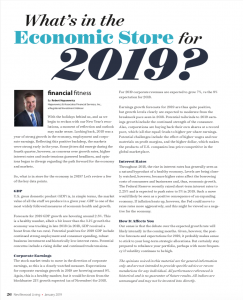This article appeared in the January 2019 edition of Nevillewood Living.
With the Holidays behind us, and as we begin to reckon with our New Year’s resolutions, a moment of reflection and outlook may make sense. Looking back, 2018 was a year of strong growth in the economy, employment and corporate earnings. Reflecting this positive backdrop, the markets were strong early in the year. Some jitters did emerge during the 4th quarter, however, as concerns over growth rates, higher interest rates and trade tensions garnered headlines, and opinions began to diverge regarding the path forward for the economy and markets.
So, what is in store for the economy in 2019? Let’s review a few of the key data points.
GDP
U.S. gross domestic product (GDP) is, in simple terms, the market value of all the stuff we produce in a given year. GDP is one of the most widely followed measures of economic health and growth.
Forecasts for 2019 GDP growth are hovering around 2.5%. This is a healthy number, albeit a bit lower than the 3.1% growth the economy was tracking in late 2018 (in 2018, GDP received a boost from the tax cuts). Potential positives for 2019 GDP include continued strong employment and consumer spending, robust business investment and historically low interest rates. Potential concerns include a rising dollar, and continued trade tensions.
Corporate Earnings
The stock market tends to move in the direction of corporate earnings, so this is a closely watched measure. Expectations for corporate earnings growth in 2019 are hovering around 9%. Again, this is a healthy number, but it would be down from the blockbuster 21% growth expected (as of November) for 2018. For 2019 corporate revenues are expected to grow 7%, vs the 9% expectation for 2018.
Earnings growth forecasts for 2019 are thus quite positive, but growth levels clearly are expected to moderate from the breakneck pace seen in 2018. Potential tailwinds to 2019 earnings growth include the continued strength of the consumer. Also, corporations are buying back their own shares at a record pace, which (all else equal) leads to higher per share earnings. Potential challenges include the effect of higher wages and raw materials on profit margins, and the higher dollar, which makes the products of U.S. companies less price competitive in the global marketplace.
Interest Rates
Throughout 2018, the rise in interest rates has generally seen as a natural byproduct of a healthy economy. Levels are being closely watched, however, because higher rates affect the borrowing costs of consumers and businesses and, thus, economic growth. The Federal Reserve recently raised short term interest rates to 2.25%, and is expected to push rates to 3% in 2019. Such a move would likely be seen as a positive consequence of an expanding economy. If inflation heats up, however, the Fed could move to raise rates more aggressively, and this might be viewed as a negative for the economy.
How It Affects You
Our sense is that the debate over the expected growth rate will likely intensify in the coming months. Given, however, the positive forecasts and expectations for 2019, it probably makes sense to stick to your long term strategic allocations. But certainly stay prepared to rebalance your portfolio, perhaps with more frequency if volatility continues to be high.
The opinions voiced in this material are for general information only and are not intended to provide specific advice or recommendations for any individual. All performance referenced is historical and is no guarantee of future results. All indices are unmanaged and may not be invested into directly.




